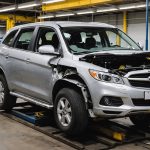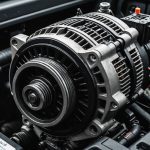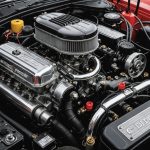Understanding Rollover Protection Systems
Vehicles come equipped with various safety features, but few are as crucial as rollover protection systems (RPS). These systems play a vital role in safeguarding passengers during a rollover accident by maintaining the integrity of the vehicle structure.
Importance of Rollover Protection
Rollover accidents, though less frequent than other types, often result in severe injuries due to the substantial forces involved. A robust RPS can significantly reduce injury risks by preventing the roof from collapsing and ensuring occupants remain within the vehicle structure. This protection is achieved through reinforced frames or specially designed bars that uphold structural integrity.
This might interest you : Maximize Your Vehicle”s Safety: A Guide to Fine-Tuning Your Automatic Emergency Braking System
Types of Rollover Protection Systems
There are several types of RPS found in modern vehicles:
- Fixed Rollover Bars: Typically used in convertibles, providing a solid frame to resist the impact.
- Deployable Rollover Bars: These systems automatically extend from the vehicle structure when a rollover is imminent, offering dynamic protection.
- Integrated Roof Structures: Built into the vehicle’s design, they utilize the strength of the overall structure to maintain safety.
Legal Regulations and Safety Standards
Governments worldwide enforce strict safety standards to ensure vehicles come equipped with adequate rollover protection. Regulations often detail specific requirements for RPS, such as minimum structural strength and deployment criteria, aiming to enhance overall vehicle safety.
Topic to read : Top Techniques for Assessing Vehicle Frame Integrity Post-Accident: A Comprehensive Guide
Importance of Maintenance for Rollover Protection Systems
Maintaining rollover protection systems is crucial for ensuring vehicle safety. Regular vehicle maintenance can prevent catastrophic failures. Key to this is performing consistent safety checkups. Start by adhering to a schedule that includes inspection of all rollover protection features. Look for signs of wear and tear, such as dents or misalignments, as these can compromise the system’s effectiveness.
Common issues include loose components or rust, which can undermine safety. Identifying these problems early is vital. For example, a visual check for corrosion can save you from more extensive damage, preserving system longevity. It’s important not only to spot issues but to act on them promptly.
While DIY checks can be helpful, they are not a substitute for professional assessments. Technicians have the expertise and tools to conduct thorough inspections and address hidden faults that might not be visible to the untrained eye. Trusting professionals ensures the system meets safety standards and thus offers the required protection.
Incorporate both proactive DIY checks and professional assessments in your vehicle maintenance strategy. This combination will enhance the reliability of your rollover protection systems, ensuring they operate effectively when needed and extending their lifespan.
Practical Tips for Enhancing Rollover Protection
When considering safety tips to minimize rollover risks, the most important factor is careful driving behavior. Always maintain a safe speed, especially when navigating curves or wet roads. Avoid sudden turns or abrupt manoeuvres that could destabilise your vehicle.
An effective way to boost safety is by implementing protective measures such as aftermarket modifications. Installing stabiliser bars can improve your vehicle’s balance, reducing the likelihood of a rollover. If you drive an SUV or a truck, consider upgrading to anti-roll bars for better control.
Attention to weight distribution and load management plays a crucial role in preventing rollovers. Ensure you distribute loads evenly across the vehicle. Overloading one side can cause imbalance. Secure carry items tightly, as loose items can shift and disturb your vehicle’s center of gravity during sudden stops or turns.
Enhancements like reinforced roof structures can offer added protection in case of an accident. Vehicles with low centers of gravity naturally exhibit a decreased propensity to roll over. Alterations such as lowering the suspension can assist in achieving this balance.
Remember, every measure matters. Implementing these practices contributes not only to rollover protection but also to overall driving safety.
Comparing Rollover Protection Systems
When considering rollover protection systems (RPS), the options vary in system comparison concerning their effectiveness and cost analysis. Each system type offers distinct benefits and drawbacks, influenced by several factors.
System Types and Pros/Cons
Rollover bars are among the most common yet straightforward options. Their primary advantage lies in the low cost and ease of installation. However, this simplicity may mean less comprehensive protection compared to more complex systems.
Electronic stability control (ESC) systems use advanced technology to prevent rollovers altogether. While highly effective, these systems can be expensive and require ongoing maintenance to ensure optimal performance. Understanding manufacturer guarantees and potential repair costs are crucial in this context.
Factors Influencing Effectiveness
The effectiveness of a system often depends on the vehicle type and its use. For example, farm vehicles might benefit more from robust physical barriers, while high-speed vehicles fare better with technological solutions that prevent roll instability.
Cost Analysis and Value
Cost considerations are pivotal as they dictate not just immediate expenses but long-term value. For budget-conscious users, a cost-benefit analysis should include initial costs, maintenance, and system lifespan, balancing upfront affordability against long-term effectiveness and repair needs.
Visual Aids and Resources for Understanding Rollover Protection
Visual aids are crucial for grasping the intricacies of rollover protection systems. They simplify complex concepts, making them more digestible. By utilising visual guides, safety measures become clearer. These guides illustrate system components vividly, aiding in understanding their role during a rollover event.
Implementing checklists during vehicle inspections ensures a thorough review of the safety systems. Typically, such checklists will cover aspects like:
- Seat belt functionality
- Airbag readiness
- Roll cage integrity
- Stability system status
These checklists are essential tools, providing a structured approach to verifying the protection systems are fully operational.
For drivers seeking in-depth information, various safety resources are available. These resources are comprehensive, including manuals and detailed documents on regulations and systems maintenance.
- Safety Regulations: Offer a foundation for understanding legal requirements and compliance standards.
- Industry Manuals: Provide detailed technical insights into vehicle safety enhancements.
- Online Libraries: Contain articles and studies focused on the efficiency of rollover protection.
These resources empower individuals to make informed decisions about vehicle safety. Whether you are a driver, mechanic, or enthusiast, they enhance your capacity to understand, maintain, and improve rollover protection systems effectively. Engaging with visual aids, checklists, and safety resources can significantly heighten awareness and adherence to best practices in vehicle safety.











